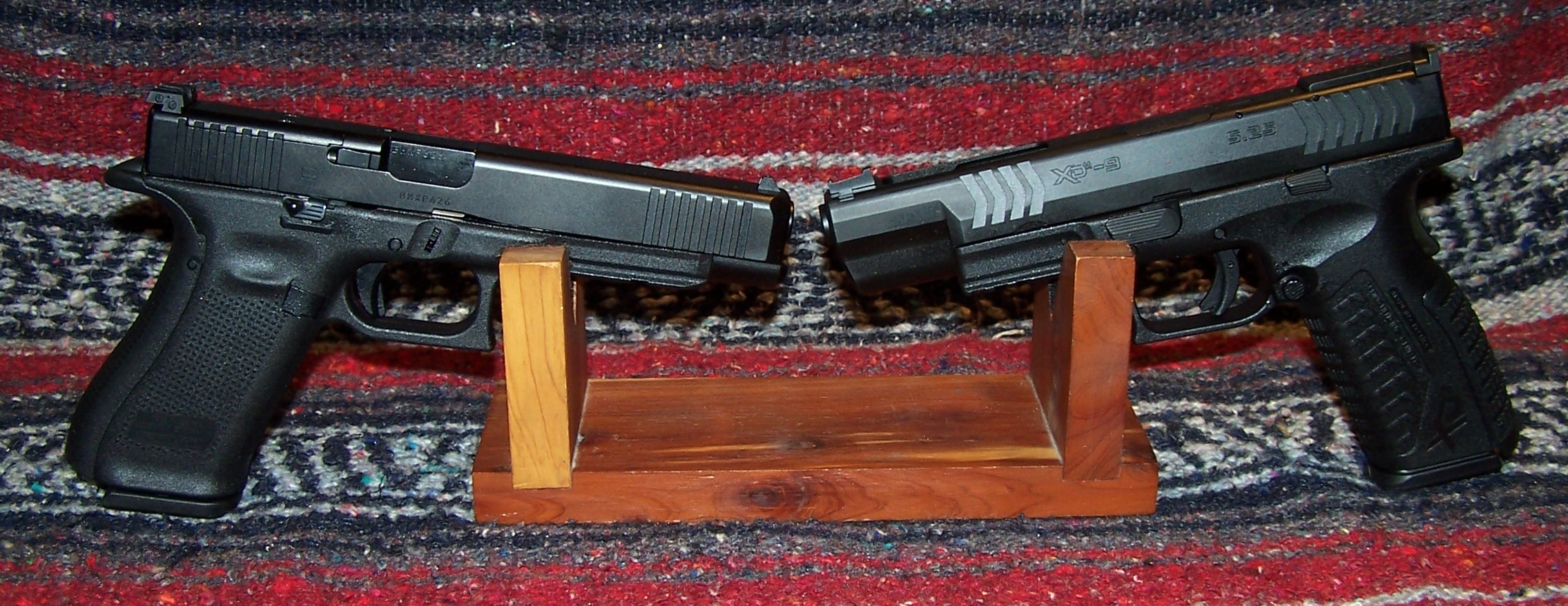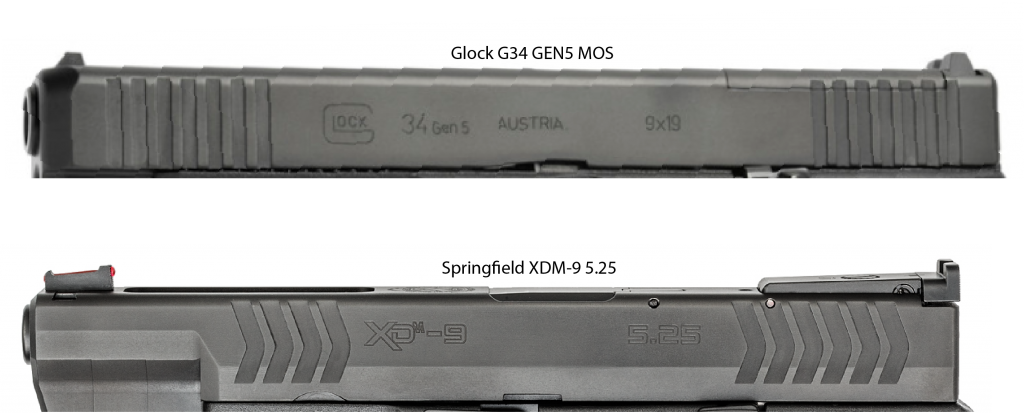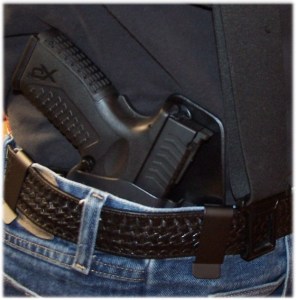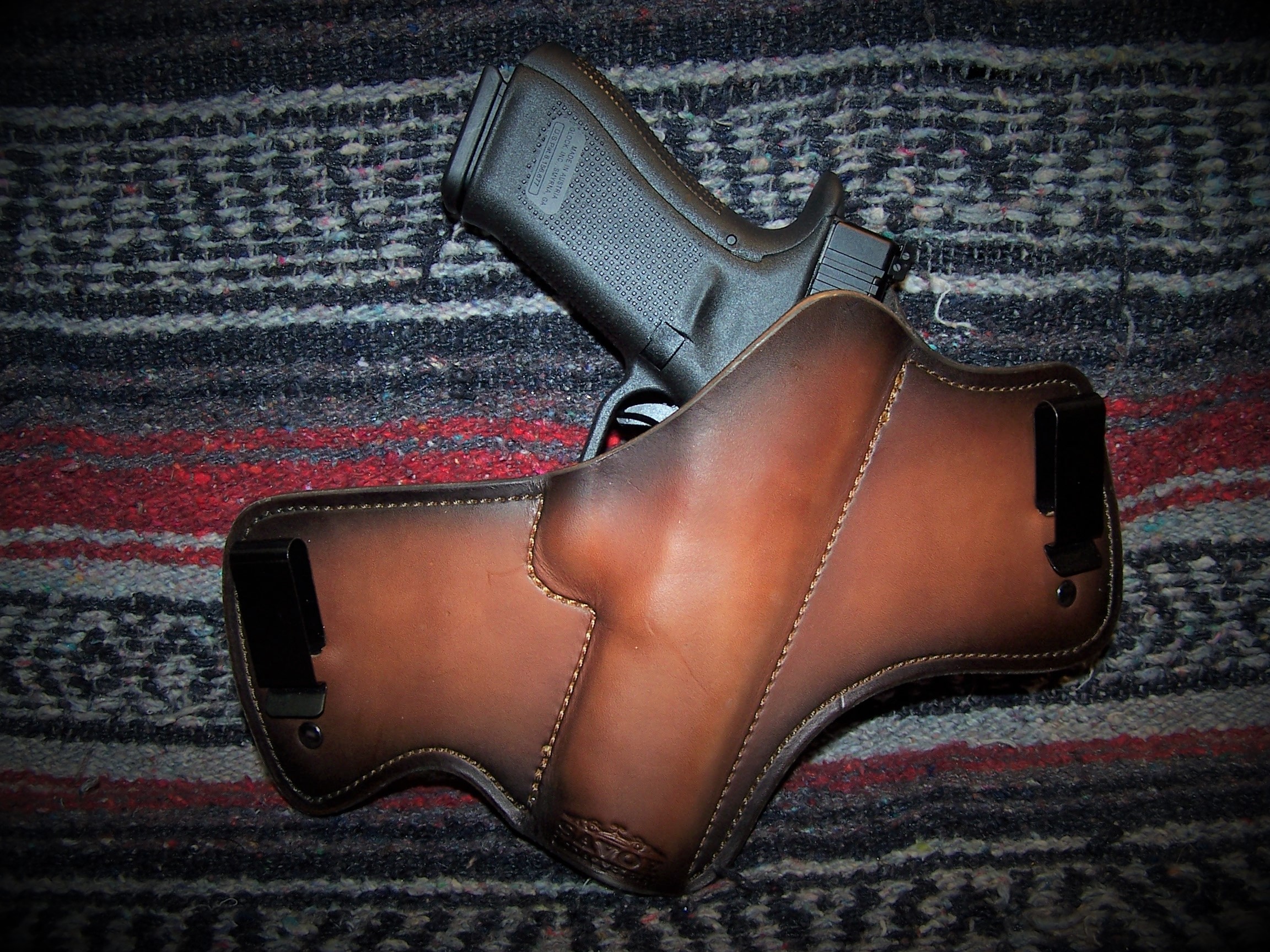
Intended for competition, the Glock G34 and the Springfield Armory XDm 5.25 will be competing for top spot in my world. Both pistols are highly respected, but only one will win top spot, but not just for competition. As I have mentioned in previous article, I always look at the concealed carry aspect of any handgun. There are handguns that, obviously, were not meant nor should they be considered for concealed carry. Others, on the other hand, are right at that borderline, and the Glock G34 and the Springfield Armory XDm 5.25 are among those. In fact, most folks would probably say; “Why Bother?”
If you carry a full-size pistol, as I do, invariably your carry piece is going to be challenged. I normally carry a full-size 1911. The Glock G34 and the Springfield Armory XDm 5.25 are, essentially, the same size as my normal carry, although they are different platforms. They also have a higher round count than my EDC. Now, I do concede the fact that there are other 9mm pistols that could be better carried IWB; they would be smaller and more concealable. They may even have the same round count as the two under scrutiny; for example, a Glock G17 and a Springfield Armory XDm 4.5 (or the 3.8). If you had the chance, in the case of the Glock G34, of at least doubling the loadout over a standard 9mm 1911 pistol, would that not at least be taken under consideration?
In the case of the Glock G34 and the Springfield Armory XDm 5.25, this was going to be a tough battle, as both pistols have many, many positives going for them. The Glock G34; however, has just received an upgrade to GEN5; whereas, the Springfield Armory XDm 5.25 remains the same as it was. Would the GEN5 version of the G34 be enough to upset the balance of power?
Specifications
| Glock G34 GEN5 MOS | XDM-9 5.25 | |
| Caliber: | 9x19mm | 9x19mm |
| System: | Safe Action® | Ultra Safety Assurance (USA) Action Trigger System™ |
| Safeties: | Three passive, independently operating, mechanical safeties (Trigger Safety, Firing Pin Safety, Drop Safety). All three safeties disengage sequentially as the trigger is pulled and automatically re-engage when the trigger is released. | Three separate safeties guard against accidental discharges and provide extra peace of mind. The Ultra Safety Assurance (USA) Action Trigger System™ prevents unintentional rearward movement of the trigger. The grip safety keeps the pistol from firing unless the shooter has a firm grasp on it. And an internal firing pin block goes the extra mile to bring you a pistol fully designed with safety in mind. |
| Controls: | Ambidextrous slide lock, swappable magazine release mechanism. | Left side only slide lock, ambidextrous magazine release. |
| Mag. Capacity: | Standard: 17, Optional: 19 / 24 / 31 / 33 | 3 – 19 Round, Stainless Steel |
| Barrel Length: | 5.31 inches | 5.25″ Hammer Forged, Steel, Melonite® / 1:10 Twist |
| Weight: | Without magazine –23.46 oz. With empty magazine – 26.21 oz. With loaded magazine – 34.57 oz. | 29 oz. |
| Trigger Pull*: | 6 pounds 12.3 ounces | 7 pounds 5.1 ounces |
| Recoil System | One-Piece Full-Length Guide Rod, Captive | One-Piece Full-Length Guide Rod, non-captive |
| Length (Overall) | 8.74 inches** | 8.5 inches |
| Slide Length | 8.15 inches | 7.0938 inches |
| Width (Overall) | 1.34 inches | 1.23 inches (@ slide lock) |
| Slide Width | 1.0 inches | 1.0 inches |
| Height incl. Mag. | 5.47 inches | 5.75 inches |
| Sighting System: | Glock dot front sight and U-Notch fully adjustable rear sight. | Fully adjustable rear sight and fiber optic front sight. |
| Line of Sight: | 7.25 inches | |
| (Polymer) 7.52 inches | ||
| (Steel) 7.48 inches | ||
| (GNS) 7.44 inches | ||
| Trigger Distance | 2.76 inches** | 2.66 inches |
| Slide Finish: | nDLC finish | Melonite® finish |
| Frame: | Nylon reinforced polymer. Interchangeable back straps (beaver-tail and non-beaver-tail). | Nylon reinforced polymer. Interchangeable mold-tru back straps |
| MOS Compatible: | Yes | No |
| MSRP: | $851.00 | $753.00 |
| * 5-Pull Average ** Dependent upon which backstrap is selected. |
Of course , there is a lot missing from the basics for both pistols. However, I hope to capture some of what is missing with the information that follows.
A Slide-by-Slide Comparison

The slide of the Glock G34 is the longer of the two pistols, due to the barrel length.
It should be evident that with both the Glock G34 and the SA 5.25, aside from a full magazine, the slide comprises most of the pistol’s weight.
Both slides incorporate front and rear serrations, with the serrations of the Glock G34 being a straight up and down pattern; whereas, the XDM is more of a ‘chevron’ type. Both types of serrations are more than adequate for retracting the slide for inspection or for chambering a cartridge.
The sights of the Springfield XDM sit higher than that on the Glock G34. Both type of sights is more than adequate for placing the pistol on target.
The slide of the Glock G34 is devoid of a lightning cut; whereas, the Springfield XDM incorporates a lighting cut. The lightning cut, according to Springfield, “… reduces reciprocating mass which allows for faster cycling and allows a larger variety of loads to be used.

A raised extractor indicates a loaded chamber with the Glock G34. The raised extractor; however, is very mild although it is both tactile and visual. The Springfield XDM, on the other hand, has a chamber loaded indicator on top of the slide that is both highly visual and tactile. In addition, a protruding pin at the rear of the XDM slide indicates that the pistol is in a cocked condition; whereas, the forward position of the Glock G34 trigger is the only indication of a cocked pistol. With the Glock G34, if a round is chambered as indicated by the raised extractor, the pistol is automatically in a semi-cocked condition. The protruding pin at the end of the XDM slide only tells you that the pistol is in a cocked condition.
Frame Comparisons

The frames of both pistols are as different as night and day.
Th frame of the Glock G34 is the less sculptured of the two but is also the thicker (in my hand). Note that I have added the largest backstrap adapter with beaver-tail on my G34. The trigger reach is 2.76 inches. I have not added a grip adapter to the XDM. The trigger reach is 2.66 inches (with grip safety pressed fully inward).
Neither grip incorporates finger grooves.
Both frames incorporate a rail for mounting accessories.
Both trigger guards are squared-off at the front for finger indexing for those that do that sort of thing. The front trigger guard texturing is different with the XDm being the more aggressive of the two.
The texture of the grip on the G34 is genuinely nice, unlike the previous RTF texture. It provides a good gripping surface without being abusive to the hand. The grip angle is, of course, typical Glock in nature. The grip hump is lower than the XDM and fits my hand well; it is amazingly comfortable.
The mega-lock frame texture of the XDM is good without being abusive to the hand. If you are used to the grip on a 1911 pistol, the grip angle of the XDM will be right at home in your hand.
The slide lock of the G34 is typical Glock; whereas, the extended slide catch is ambidextrous. The slide lock of the XDM is a lever and is left-side only, as is the slide catch. While not extended, there is plenty of surface area to operate the slide lock and slide catch on the XDM.
The rear of the grip on the XDm incorporates the grip safety that must be fully pressed inward before the pistol can fire. It also must be pressed fully inward to retract the slide, during assembly or normal operation. Whether you like a grip safety I leave up to you. I am used to it after running a 1911 for many years and enjoy the little extra measure of safety it provides. The Glock, as you know, does not incorporate a grip safety.
The grip length on both pistols is more than adequate to fill the hand.
Handling (Ergonomics)
Although the Glock G34 and Springfield XDm pistols are competition pistol with longer barrels than their non-competition counterparts, they handle extremely well. The ergonomics of both pistols is excellent, and it really comes down to which pistols feels more right to you in the hand. They both feel good to me. Controls are easy to reach and to operate.
Both pistols are quick to get into target acquisition, but I have to say that the Glock G34 provides the better sight arrangement to me. Note that the polymer target sights have been replaced with Glock Night Sights (GNS), as my primary interest in the G34 is for self-defense. In good light, the fiber front sight of the XDM is more than adequate but would not be the best sight to use in dark conditions. However, the XDM is intended for competition use and not ‘tactical’ use. If I was to carry or use the XDM for defensive purposes, a good set of dual-purpose sights (one that I could use 24/7 in all lighting conditions) would find their way onto the pistol.
Of the two pistols, the G34 and the XDM, I am hard pressed to say which handles better. The trigger reach of the Glock G34 is more forward than the XDM, primarily due to the design of the grip and the use of the largest grip adapter (with beaver-tail) that places the trigger reach at 3.0 inches as compared to 2.66 inches with the XDM. Because I have (somewhat) long fingers, I prefer the G34 to the XDM. Had the grip adapters of the XDM been like that on the G34 (the beaver-tail) I might not be able to say the same. With the XDM, the trigger reach is the same regardless of what grip adapter is used. The grip adapter only places a different pressure against the palm of the hand by adding or subtracting the thickness of the grip adapter bump.
Disassembly, after clearing the Glock G34 is standard Glock. Pull the slide slightly to the rear, push or pull down on the slide lock, pull the trigger, and remove the slide from the front of the pistol. After clearing the Springfield XDM 5.25, pull the slide slightly rearward, rotate the slide lock lever down, and remove slide from frame. There is no need to pull the trigger, and that is a feature that many like.
To save words, I cannot say what pistol would be best for you. You need to handle both and determine this for yourself.
Handling Under Fire
It does not mater, of course, what a pistol feels like just handling it. It does matter how a pistol handles when firing it. I have had pistol (and revolvers) where they seem to be lacking in the user-friendly category but handle extremely well when being shot.
Although the G34 and XDM are polymer striker-fired pistols, they handle differently when pulling the triggers of each. While I do like the trigger on the Springfield XDM, I do have to say that I like the Glock G34 trigger better. The Glock G34 trigger has a more positive response to pull than that of the XDM.
The trigger of the XDM has more take-up than the trigger of the G34 as it approaches the wall. The break of the G34 trigger is crisp with just a hint of mushiness; whereas, the XDM trigger exhibits a good degree of mushiness before the break. The break on the XDM trigger is crisp with just a hint of overtravel. Reset on the XDM is a bit long but can be trained through. With the G34, there is some resistance before the break as the striker is placed in its full-cocked position. The break is clean with no over-travel. Reset is short and positive. With that said, the handling of the trigger on both pistols, while different, is easily manageable with trigger time.
Felt recoil with both pistols is about the same – very mild. Although the XDM has a higher bore axis than the G34, I really did not detect any more muzzle flip over the G34. With a high hand hold, especially that is possible with the beaver-tail grip adapter on the G34, the muzzle can be brought back on target pretty quickly, although I am not one to perform “magazine dumps” when I shoot; I like to savor each round fired like the bite of professionally prepared beef jerky.
Magazine changes with either pistol is positive, but I do like the ambidextrous magazine release button on the XDM when running the pistol weak hand. With the G34, I must reach underneath the pistol to engage the magazine release button with my shooting finger. I do not operate the G34 with my weak hand enough to warrant a swap of the magazine release button from left to right side, but I have considered it in an attempt to train my right trigger or forefinger for releasing magazines, although it would negate using some of my earlier magazines that are left-side only.
The magazine well beveling is excellent on both pistols but a bit more excellent on the G34, as the bevels are deeper and longer.
Once again, I cannot say which pistol would be right for you. I can only rely how each of them felt to me. The Springfield Armory XDM is a bit heavier, a bit bigger than the G34, and the trigger not as nice as the G34. But I still enjoy shooting it and I would not have any qualms about carrying it into harm’s way.
Hiding Out!

The primary intent of evaluating the Glock G34 GEN5 MOS and the Springfield Armory XDM-9 5.25 had nothing to do with competition. Rather, it had everything to do with personal defense. While the trend is to find the most compact pistols that can be safety fired, the long-slide end of the spectrum is rarely tread upon. After carrying a full-size ‘Government’ model 1911 for quite a few years, I find it hard to embrace short pistols – at least shorter than a ‘Commander’ size 1911. Except for a good sub-nosed revolver, long-barreled pistols fulfill my demand for an adequate platform from which to launch projectiles large and small.
The Glock G34 and the Springfield XDM 5.25 can be concealed, although I do admit that it takes a conscientious effort on the part of the operator to make it happen. While it is said that the butt of a pistol is the hardest to conceal, a long barrel does not help with concealment; however, the majority of the pistol forward of the grip is usually ensconced in a holster that is buried inside the waistband with a healthy holster depth and cant to minimize being outed by the general populace, and just as importantly, badge heavy LE types that can make your day.
Wearing over-sized clothing and keeping the pistol as close to the body as possible in an excellent holster, mitigates the chances of being detected. I have carried both pistols while mall-walking and also in other big-and small-box establishments without detection.




Summary

Regardless of your pistol preferences, I do not think that you can go wrong with either pistol. Both have pros and cons and usually they are up to the prospective user to decide what can be lived with…or without.
To me, the Glock G34 is the more responsive of the two pistols. But then again, there may be a pistol that is more responsive than either of these. Again, it takes research on your part to determine if either pistol would fit into your schema. And hopefully, I may be evaluating a couple of those (H&K VP9 and FNH FNS09) in the future and bring that information to you.
Resources
- G34 Gen5 MOS Competition | 9x19mm: https://us.glock.com/en/pistols/g34-gen5-mos-fs
- XD-M® 5.25″ Competition Series 9mm: https://www.springfield-armory.com/products/xdm-competition-series-9mm/
![]()

